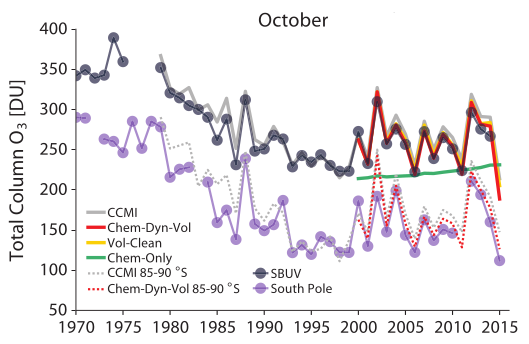Chemical Climate

Monthly averaged Antarctic total ozone column for October, from SBUV and South Pole station observations and a series of model calculations. Total ozone data measured at the geographic South Pole are from Dobson observations (filled circles) for October, when there is not sufficient sunlight for the Dobson. SBUV data for each month are compared with model runs averaged over the polar cap latitude band that is accessible by the instrument; South Pole station data are compared with simulations for 85°S to 90°S.
From Solomon, Susan, Diane Ivy, Douglas Kinnison, Michael Mills, Ryan Neely, Anja Schmidt, 2016: Emergence of healing in the Antarctic ozone layer. Science.
Strategic Direction: Chemical Climate
1. In order to improve prediction of the Earth system across scales, quantify the chemical and dynamical coupling mechanisms between the upper and lower atmosphere.
2. In order to inform mitigation policies, identify the life cycle of short-term climate pollutants (reactive species and aerosols) and their impacts on climate.
3. In order to characterize the resilience of the Earth system to natural and anthropogenic disturbances, evaluate the role of chemical and biogeochemical feedbacks in the climate system.
Focus 2 on Chemical Climate: The Influence of the Middle and Upper Atmosphere on Climate Variability and Change.
Climate Projects
- Geoengineering: Analyzing proposals to modify the climate in order to reduce climate change.
- MOPITT: Satellite measurements provide a long record of carbon monoxide since March 2000.
- MUSICA: Multi-Scale Chemistry Modeling.
- Regional & Process Modeling.
- UTLS: Upper Troposphere - Lower Stratosphere.
- WACCM: Whole Atmosphere Community Climate Model.
- WRF-Chem: Weather Research and Forecasting model coupled with Chemistry.